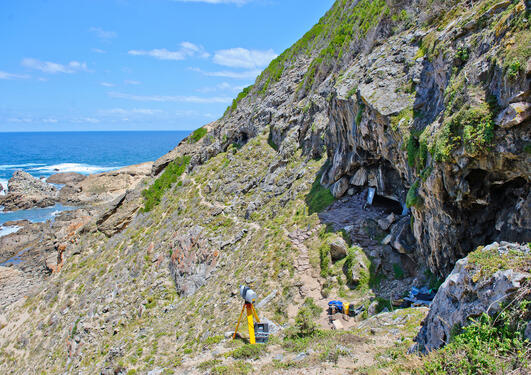UiB researcher sheds new light on the origin of sewing technologies
The earliest known bone awls, suitable to produce skin clothing, are 73 000 years old and come from Blombos Cave, a site investigated by the researchers of the UiB Centre for Early Sapiens Behaviour. However, little is known about the origin of the sewing techniques necessary to produce tailored clothing. A new study, lead by Francesco d’Errico, professor II at the University of Bergen and Bordeaux, clarifies the origin and evolution of the technology that allows us to keep warm.

Main content
Genetic studies on human lice suggests the speciation between head lice and those living on clothing occurred between 100,000 and 70,000 years ago. This finding implies that some human populations were regularly wearing clothing prior to this event.
The evolution of sewing
Eyed needles made of bone, antler, and ivory had been found at a number of Palaeolithic sites in Europe, Asia, and North America. However, prior to this study, no research had been undertaken with the goal of gathering all the available data, i.e. information on thousands of needles from hundreds of sites, and combining them with analyses of new collections with the aim of understanding the first 30,000 years of the history of sewing. The results of this study, to which Chinese, Canadian, Czech and French researchers have participated, is published in the latest issue of the Journal of Human Evolution.
"Our research shows that eyed needles were probably independently invented in China and Siberia, around 42 000 years ago, and became more and more diversified since then, probably to fullfil new tasks such as the production of embroidery, undergarments, clothes for children and similar", says d’Errico.
Early fashion days
"In Europe, this tool appears sporadically around 26,000 years ago, and was part of the toolkit used by the hunters that colonized the American continent some 14,000 years ago. Needles are the perfect tool to produce the clothes necessary to live in harsh environments such as those occupied by some populations in the northern hemisphere during the Pleistocene", says d’Errico.
"The variability of the earliest European needles reveals different technological traditions, which probably reflect different ways of making clothes and clothing styles specific to each European region. This suggests that since the Palaeolithic fashion was an important aspect of social life and that the manufacture of quality clothing satisfied both physiological needs and social norms".
A complex technology
Eyed needles are complex bone tools to make because they must be thin and have a hole at one end, which is difficult to achieve with grindstones and stone tools, d’Errico explains. They are also quite fragile and can be resharpened only if they break close to the point, leaving enough space to handle the resharpend tool while sewing.
"In traditional societies, clothes are always submitted to both cultural and functional imperatives. Needles have played an important role in expanding the range of possibilities that humans have of culturalising their body, and make visible and explicit social differences and ethnic affiliations. The use of needles to manufacture tailored clothes requires a long apprenticeship".
All this suggests, says d’Errico, that the production and use of needles can only occur in complex societies, able to transmit a complex technical knowledge.


